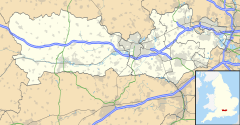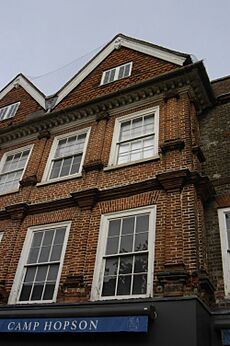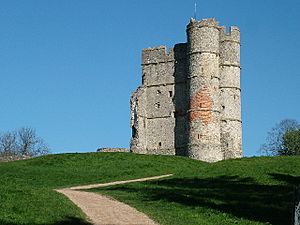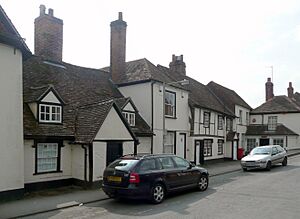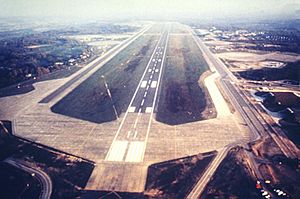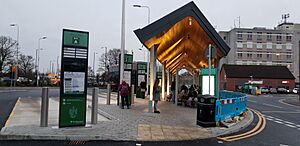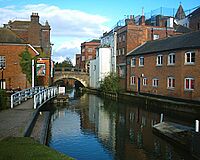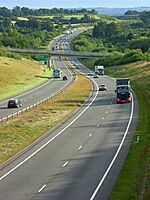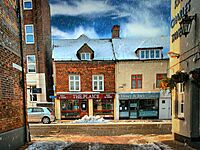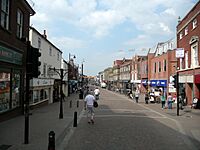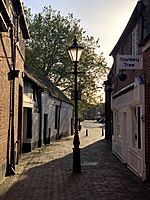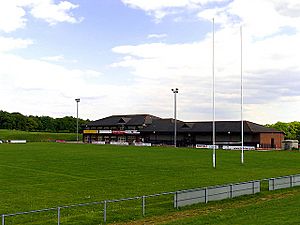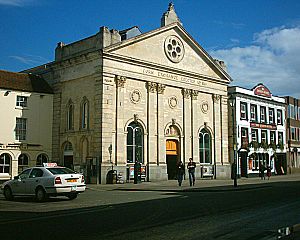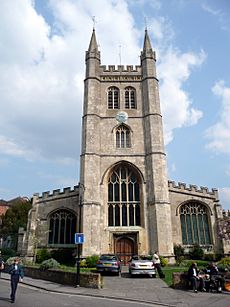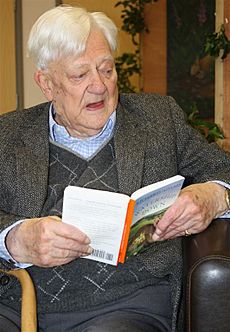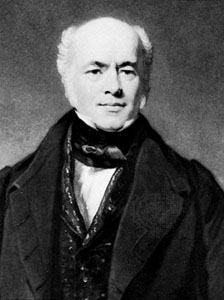Newbury, Berkshire facts for kids
Quick facts for kids Newbury |
|
|---|---|
| Market town | |
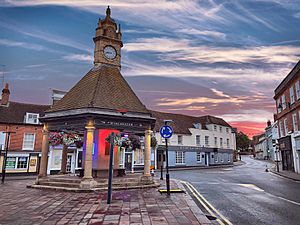 Newbury clock tower at sunset in 2018 |
|
 Flag |
|
| Area | 9.9 km2 (3.8 sq mi) |
| Population | 33,841 (Parish, 2021) 42,260 (Built up area, 2021) |
| OS grid reference | SU4767 |
| • London | 60 mi (100 km) |
| Civil parish |
|
| Unitary authority |
|
| Ceremonial county | |
| Region | |
| Country | England |
| Sovereign state | United Kingdom |
| Post town | NEWBURY |
| Postcode district | RG14 |
| Dialling code | 01635 |
| Police | Thames Valley |
| Fire | Royal Berkshire |
| Ambulance | South Central |
| EU Parliament | South East England |
| UK Parliament |
|
Newbury is a lively market town in West Berkshire, England. It sits in the beautiful valley of the River Kennet. The town is about 26 miles (42 km) south of Oxford. It is also where the main offices for West Berkshire Council are located.
Newbury is on the edge of the Berkshire Downs. This is a lovely area known for its natural beauty. Just 3 miles (5 km) north of the Hampshire–Berkshire county line. In the nearby village of Donnington you can find the partly ruined Donnington Castle. The hills around Newbury are famous for training racehorses. Many of these horses train near Lambourn. To the south are more hills, including Walbury Hill. You can also find private gardens and big houses like Highclere Castle there.
Newbury's economy is linked to the eastern M4 corridor. This area has many businesses, especially around Reading, Bracknell, Maidenhead, and Slough. Newbury and the nearby town of Thatcham form a larger urban area. About 70,000 people live in this area.
Newbury is also home to Newbury Racecourse. It is the main office for the mobile phone company Vodafone. The software company Micro Focus International is also based here. The town centre has a big market square. You can see a rare medieval building called the Cloth Hall. There is also a 15th-century church, St Nicolas Church. Many other buildings from the 17th and 18th centuries are also still standing.
Contents
Discovering Newbury's Past
People lived in Newbury even in the Mesolithic period (Middle Stone Age). Tools and other items were found at Greenham Dairy Farm in 1963. More discoveries were made during the building of the Newbury Bypass. Newbury was founded in the late 11th century. This was after the Norman conquest. It was a "new borough," which is how it got its name.
There might have been a Newbury Castle. Kings like King John and Henry III visited Newbury often. They came here for hunting. The first mention of a bridge in Newbury was in the 14th century. King Edward II said the bridge should be kept in good condition in 1312. By 1623, the bridge was made of wood and had shops on it. It collapsed but was rebuilt.
Newbury's Cloth Trade History
Newbury was once famous for its cloth trade. A rich cloth maker named Jack of Newbury lived here in the 16th century. He might have owned the first factory in England. There's a local story about the "Newbury Coat." It was a bet to see if a suit could be made from a sheep's wool in just one day! This story was even written about in a funny novel by Elizabethan writer Thomas Deloney.
English Civil War Battles
Newbury was the site of two important battles during the English Civil War. The First Battle of Newbury happened in 1643. The Second Battle of Newbury took place in 1644. After the second battle, nearby Donnington Castle was left in ruins. The war and problems with the cloth trade made Newbury quite poor for a while.
Coaching Inns and Canals
In the 18th century, Newbury became busy again. This was because Bath became a popular place for rich people from London. Newbury was about halfway between London and Bath. It was a perfect stop for travellers on their two-day journey. Many coaching inns, which were like hotels for travellers and their horses, opened in Newbury. One inn, the George & Pelican, could stable 300 horses! A theatre was also built for entertainment.
In 1723, the Kennet Navigation made the River Kennet easier to travel on. It connected Newbury to the River Thames in Reading. Later, in 1794, work began on the Kennet and Avon Canal. This canal connected Newbury all the way to Bath. It created a water route between London and Bristol. This route was finished in 1810.
The Arrival of Railways
The opening of the Great Western Railway in 1841 changed things. It connected London to Bath, which made the canal and coaching businesses less popular. Newbury got its first railway line in 1847. It became a main railway line in 1906. This helped Newbury's economy, which was mostly based on farming and horse-racing.
In the 1980s, the electronics company Racal decided to put their new mobile phone company, Racal Vodafone, in Newbury. This company later became Vodafone UK. Since then, Newbury has become a centre for high-tech businesses. The town has become much more successful.
Greenham Common's Role in History
During the Second World War, a large Royal Air Force base was built at Greenham Common. In the 1950s, it became a base for US Air Force bombers. It had the longest military runway in the United Kingdom. In the 1980s, it became a site for nuclear cruise missiles. This led to big protests with up to 40,000 people. The Greenham Common Women's Peace Camp was set up there.
After the Cold War ended, the base closed. The runway was broken up. Much of it was used to build the Newbury bypass. The area was turned back into heathland. Greenham and Crookham commons reopened to the public in 2000.
The 1943 Bombing
On February 10, 1943, two German bombers attacked Newbury. They dropped eight bombs over the town. There was no time for a warning siren. The Senior Council School, St. Bartholomew's Almshouses, and St. John's Church were all destroyed. Many other homes were damaged. Sadly, 15 people were killed and 41 were injured. St John's Church was completely rebuilt after the war.
Newbury's Geography and Landscape
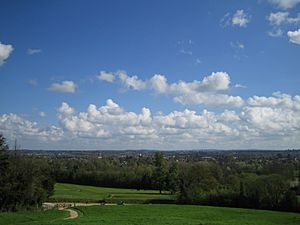
The town of Newbury includes areas like Wash Common, The City, West Fields, East Fields, and Speenhamland. The larger Newbury area also includes nearby villages. These are Speen, Donnington, Shaw, and Greenham. Speen is now a part of western Newbury.
The land in Newbury varies in height. It ranges from 72 metres (236 ft) to 122 metres (400 ft) at Wash Common. The hills nearby reach 150–200 metres (490–660 ft). The River Kennet and the Kennet and Avon Canal flow through the town. They go east to reach the River Thames at Reading. The River Lambourn flows along Newbury's northern edge. A smaller river, the River Enborne, forms the southern border. It also marks the county line with Hampshire.
Next to the town's south-eastern border is Greenham Common. You can also find the famous Newbury Racecourse there. Newbury is surrounded on three sides by the North Wessex Downs. The hills to the south offer amazing views. These include Watership Down (famous from the book), Beacon Hill, and Walbury Hill.
Newbury's Economy and Businesses
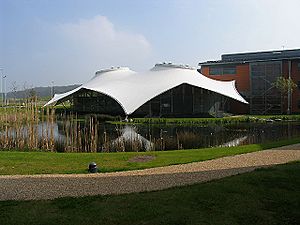
Newbury is the main business and shopping centre for West Berkshire. Its economy is connected to the eastern M4 corridor. This area has many industrial and research businesses. Newbury is home to the United Kingdom headquarters of Vodafone. Vodafone is the town's biggest employer, with over 6,000 workers. Before 2002, Vodafone used 64 different buildings across the town centre.
Besides Vodafone, other companies have their UK headquarters in Newbury. These include National Instruments, Micro Focus, Stryker Corporation, Cognito, EValue, and Newbury Building Society. The pharmaceutical company Bayer AG also has offices here.
Getting Around Newbury
Train Travel
Newbury has two train stations: Newbury and Newbury Racecourse. Both are on the line that goes from Reading to Taunton. There used to be another railway line, the Didcot, Newbury and Southampton Railway, but it closed in the 1960s.
Road Connections
The A4 road from London to Bristol also goes through Newbury. This used to be the main route west from London. Now, the M4 motorway is the main long-distance road. You can get onto the M4 about 3 miles (5 km) north of Newbury.
Newbury is also crossed by the A34 road. This is a major road that goes from Southampton on the south coast to the Midlands. The A34 now goes around Newbury to the west, helping to reduce traffic in the town centre.
Before the bypass was built, the A34 and A4 roads met in the town centre. This caused a lot of traffic. In 2007, a sculpture called Couple in Conversation was put on the roundabout. It became a new landmark for people entering the town. Other important roads from Newbury include the A339 to Basingstoke and the M3 motorway.
Bus Services
Most local bus services in Newbury are run by "Newbury & District." This is part of Reading Buses. Stagecoach South also runs routes to Woolton Hill, Andover, and Basingstoke. Thames Travel operates routes to Harwell Campus and Didcot.
The Newbury Bypass
Newbury used to have a lot of traffic because it was at the crossing of two major routes. The Newbury bypass was planned in 1981 to help with this. The road was built and opened in 1998. This bypass helped traffic flow much better around the town. In 2004, the junction with the M4 motorway was also improved. This allowed traffic on the A34 to completely avoid the town centre.
-
The Kennet and Avon Canal runs through the middle of Newbury
Schools and Learning in Newbury
Newbury has three main secondary schools:
- St. Bartholomew's School – This is one of the oldest schools in Berkshire, started in 1466.
- Park House School
- Trinity School – This school was formed after Shaw House School and Turnpike School closed.
There is also Newbury College. This college offers further and higher education. Mary Hare School is a special school for deaf students.
Some independent (private) schools nearby include:
- Horris Hill – an all-boys school.
- Downe House School
- Cheam School
- St Gabriel's School – a school for both boys and girls.
- Thorngrove School – a day school in nearby Highclere.
- Newbury Hall School – an international high school.
- St Michael's School – a Roman Catholic school in Burghclere.
Sports and Fun Activities
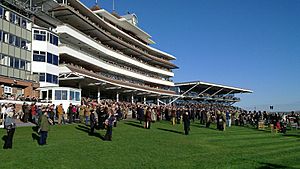
Newbury is home to Newbury Racecourse, one of England's major horse racing tracks. The first race meeting was held here in 1905. The most important race is the Hennessy Gold Cup. The Racecourse also hosts concerts during the summer. Famous singers like Olly Murs and Tom Jones have performed here.
Northcroft Lido is one of the few remaining outdoor swimming pools in the UK. It was built in the 1890s, and the current pool is from the 1930s. It was renovated in 2023 and is still used today.
Newbury used to have a football club called A.F.C. Newbury. A new team, Newbury F.C., was formed in 2007. They are working to restore their home ground at Faraday Road.
Newbury's rugby union club, Newbury R.F.C., was founded in 1928. They have a special ground at Monks Lane. The town also has two cricket teams. Newbury Cricket Club was founded in 1822. Falkland Cricket Club hosted the first professional cricket match in West Berkshire in 2023.
Newbury has two athletics clubs, Team Kennet and Newbury Athletics Club. They train at the Crookham Common Athletics Track. There are also several golf courses in the town. One notable course is at the historic Donnington Grove estate.
Victoria Park is the town's main park. It has tennis courts, a boating pond, and a skatepark. The park is used for many local events, like the Newbury Waterways Festival.
Newbury's arts scene is mainly at the Corn Exchange. This is a theatre and cinema with 400 seats. It hosts both professional and amateur shows. The English rock band the Who even played here in 1966. The Watermill Theatre is just outside Newbury in Bagnor. The former Greenham Common air force base now has The Base. This is an arts centre that opened in 2019.
Since 1979, the Newbury Spring Festival has brought famous musicians to the town. The Newbury Comedy Festival was a big event from 2004 to 2012. It featured comedians like Alan Carr and Jo Brand.
The Newbury Showground hosts major local events. It holds the annual Newbury Show every September. This farming show attracts over 50,000 visitors.
Local News and Media
Local news and TV shows for Newbury come from BBC South and ITV Meridian.
There are four main local radio stations in the Newbury area:
- BBC Radio Berkshire
- Kennet Radio (a community radio station)
- Greatest Hits Radio Berkshire & North Hampshire (broadcasts from Newbury)
- Heart South (broadcasts from Reading)
Newbury also has local newspapers:
- Newbury Weekly News
- Newbury & Thatcham Chronicle
Places to Visit in Newbury
- The Corn Exchange – a theatre and cinema.
- Kennet and Avon Canal shop and tearooms.
- West Berkshire Museum.
- Jack of Newbury's House – a historic building.
- St Nicolas' Church (CofE) – finished in 1532, a great example of old church style.
- St Joseph's Church, Newbury – a Roman Catholic church with Italian-style architecture.
- St Bartholomew's Hospital (almshouses) – old homes for people in need.
- Raymond Almshouses – built in 1796.
- The Litten Chapel.
- The Falkland Memorial.
- Donnington Castle – a historic ruined castle.
- Nearby places: Bucklebury Farm Park, Combe Gibbet, Highclere Castle, The Nature Discovery Centre, the Watermill Theatre, and Watership Down.
- New Greenham Arts – an old US military building now used for artists and performances.
- Greenham Control Tower cafe and museum – learn about the old airbase.
Famous People from Newbury
Many notable people have lived, worked, or were born in Newbury:
- Richard Adams (1920–2016) – a famous author.
- Francis Baily (1774–1844) – an astronomer.
- Michael Bond (1926–2017) – the creator of Paddington Bear.
- Bruno Brookes (1959–) – a radio and television presenter.
- Lord Carey (1935–) – a former Archbishop of Canterbury.
- Lawrence Chaney (1996–) – a drag performer.
- Keith Chegwin (1957–2017) – a television presenter.
- Miles Coverdale (1488–1569) – a bishop who helped write the first English Bible.
- Sebastian Faulks (1953–) – an author.
- Gerald Finzi (1901–1956) – a composer.
- Sir Michael Hordern (1911–1995) – an actor.
- Luke Humphries (1995–) – a professional darts player.
- William Marshal (1147–1219) – a famous medieval knight.
- Jack O'Newbury (1489–1557) – a rich cloth merchant.
- John Septimus Roe (1797–1878) – an early Australian explorer.
- "Lord" George Sanger (1825–1911) – a circus owner.
- Hannah Snell (1723–1792) – a female soldier.
- Theo Walcott (1989–) – a retired footballer who played for Southampton and Arsenal.
- Sir Frank Williams (1942–2021) – a Formula One team founder.
- Tim Jeffrey (1996-) – a Paralympic shooter for Team GB.
Some nobles who died at the First Battle of Newbury:
See also
 In Spanish: Newbury para niños
In Spanish: Newbury para niños


